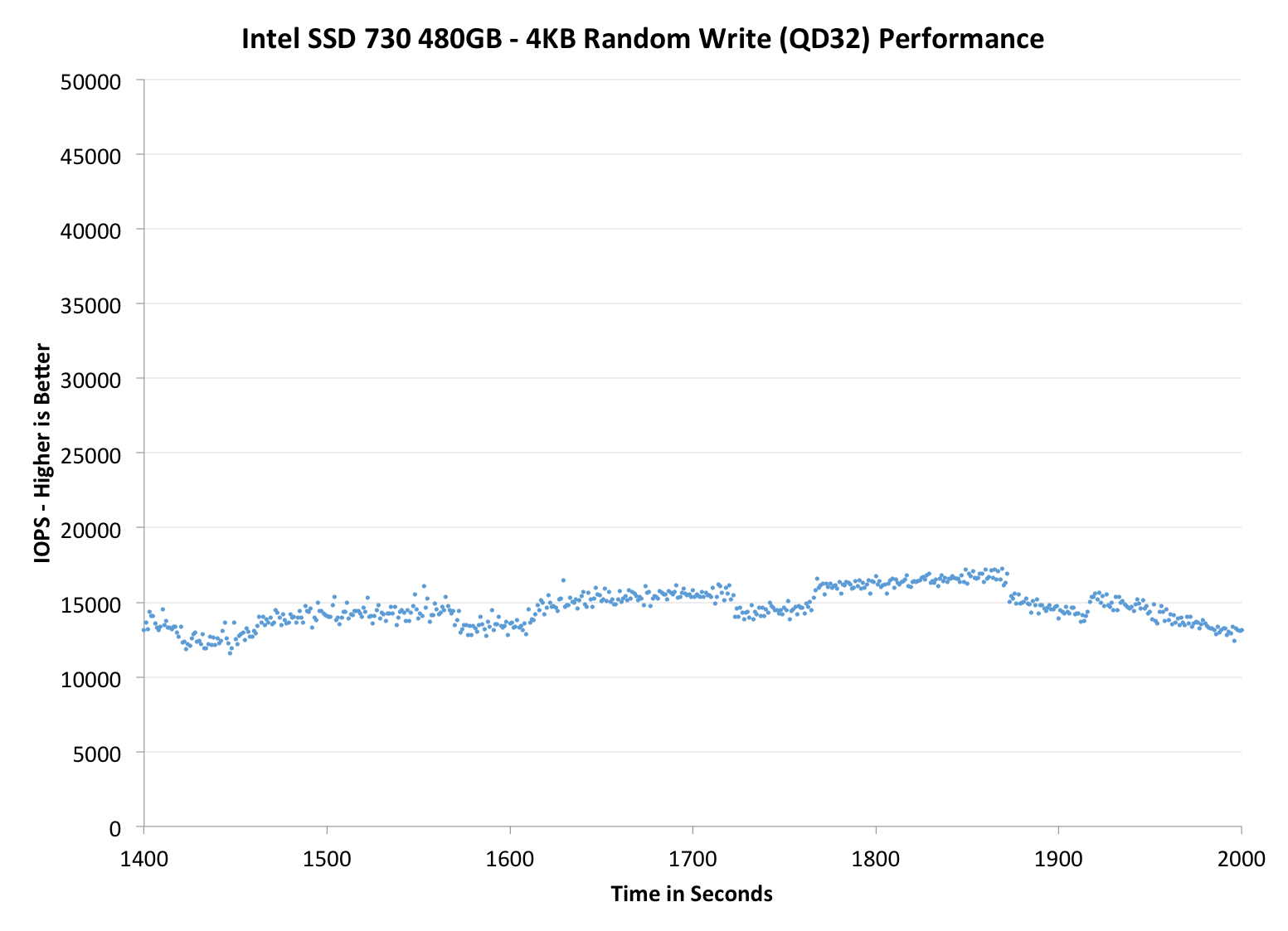Intel SSD 730 (480GB) Review: Bringing Enterprise to the Consumers
by Kristian Vättö on February 27, 2014 12:00 PM EST- Posted in
- Storage
- SSDs
- Intel
- Intel SSD 730
Performance Consistency
Performance consistency tells us a lot about the architecture of these SSDs and how they handle internal defragmentation. The reason we don’t have consistent IO latency with SSD is because inevitably all controllers have to do some amount of defragmentation or garbage collection in order to continue operating at high speeds. When and how an SSD decides to run its defrag or cleanup routines directly impacts the user experience as inconsistent performance results in application slowdowns.
To test IO consistency, we fill a secure erased SSD with sequential data to ensure that all user accessible LBAs have data associated with them. Next we kick off a 4KB random write workload across all LBAs at a queue depth of 32 using incompressible data. The test is run for just over half an hour and we record instantaneous IOPS every second.
We are also testing drives with added over-provisioning by limiting the LBA range. This gives us a look into the drive’s behavior with varying levels of empty space, which is frankly a more realistic approach for client workloads.
Each of the three graphs has its own purpose. The first one is of the whole duration of the test in log scale. The second and third one zoom into the beginning of steady-state operation (t=1400s) but on different scales: the second one uses log scale for easy comparison whereas the third one uses linear scale for better visualization of differences between drives. Click the buttons below each graph to switch the source data.
For more detailed description of the test and why performance consistency matters, read our original Intel SSD DC S3700 article.
 |
|||||||||
| Intel SSD 730 480GB | Intel DC S3500 480GB | Intel SSD 530 240GB | SanDisk Extreme II 480GB | Seagate 600 480GB | |||||
| Default | |||||||||
| 25% Spare Area | - | - | |||||||
Thanks to the enterprise DNA in the SSD 730, IO consistency is outstanding. We are looking at S3500 level consistency here, which isn't surprising given the similarity between the two. The faster controller and NAND interface mainly help with peak performance but IO consistency is built deep into the architecture of the drive. The only drive that can really challenge the SSD 730 is OCZ's Vector 150 while even the SanDisk Extreme II falls short once it reaches steady-state. Also of note is that Increasing the OP yields a healthy boost in performance and the SSD 730 actually manages more IOPS than the S3700 even though it has slightly less OP (25% vs 28%).
 |
|||||||||
| Intel SSD 730 480GB | Intel DC S3500 480GB | Intel SSD 530 240GB | SanDisk Extreme II 480GB | Seagate 600 480GB | |||||
| Default | |||||||||
| 25% Spare Area | - | - | |||||||
Here you can see the differences a bit better with the linear scale. The SSD 730 manages around 15K IOPS compared to a slighly lower 10K IOPS on the SanDisk Extreme II. With the increased overprovisioning, the SSD 730 is in a class of its own, maintaining a minimum 30K IOPS.
 |
|||||||||
| Intel SSD 730 480GB | Intel DC S3500 480GB | Intel SSD 530 240GB | SanDisk Extreme II 480GB | Seagate 600 480GB | |||||
| Default | |||||||||
| 25% Spare Area | - | - | |||||||
TRIM Validation
To test TRIM, I filled the drive with incompressible sequential data and proceeded with 120 minutes of incompressible 4KB random writes at queue depth of 32. I measured performance with Iometer after issuing a single TRIM pass to the drive.
| Intel SSD 730 Resiliency - Iometer Sequential Write | |||
| Clean | After TRIM | ||
| Intel SSD 530 240GB | 351.3MB/s | 402.9MB/s | |
TRIM definitely works as performance is actually higher than after a secure erase.










96 Comments
View All Comments
gevorg - Thursday, February 27, 2014 - link
Whats up with the satanic skull? LOL!DanNeely - Thursday, February 27, 2014 - link
The tacky gamer bling is intended to convince corporate purchasing to buy the more expensive S3500 instead.littlebitstrouds - Thursday, February 27, 2014 - link
Well aren't you mean today. Just because it doesn't fit your style, doesn't mean you need to be a jerk about it.Homeles - Friday, February 28, 2014 - link
I thought it was funny!alyarb - Friday, February 28, 2014 - link
and insightful! it's not like you saw skulltrail boards in 2P workstations either. you have to pay extra to get the plain green board.ddriver - Friday, February 28, 2014 - link
This hard drive is poisonous.tabascosauz - Saturday, March 1, 2014 - link
It's probably like the skull on Intel's motherboards; just a logo that's been there for so long that it's become an icon of Intel in the consumer market. I still like the old peel-up-for-silicon Intel design on my SSD 530 though, but not that it matters since there's only one case that showcases SSDs (H440).Anonymous Blowhard - Friday, February 28, 2014 - link
sarchasm (sar-kaz-im)1. the gulf between the author of sarcastic wit and the person who doesn't get it
DanNeely - Friday, February 28, 2014 - link
I intended describing it as 'tacky gamer bling' as being charitable. If I felt like being mean I'd've used something like 'eye searingly hideous' instead.Oxford Guy - Thursday, March 6, 2014 - link
It's really idiotic.Intel looks like a foolish old man trying to be cool with that.